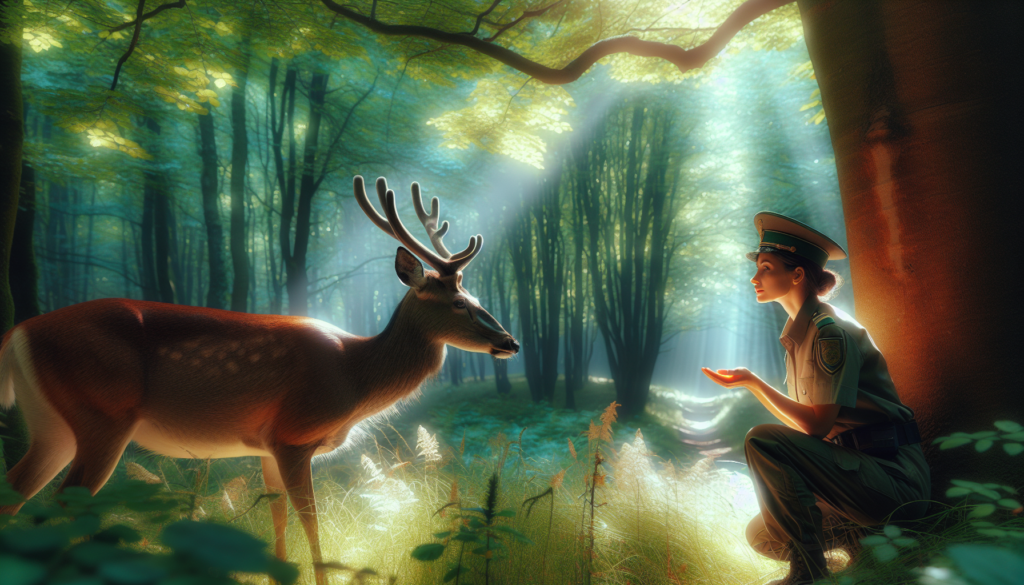Encountering wildlife can be a thrilling and awe-inspiring experience, but it can also be quite intimidating if you don’t know how to handle it. Whether you stumble upon a fox wandering in your backyard or come face-to-face with a curious bear on a hike, knowing how to respond is crucial for both your safety and the well-being of the animals. In this article, we will explore some essential tips and guidelines on how to deal with wildlife encounters, ensuring a harmonious coexistence with the natural world around you. So, let’s get started!
Understanding Wildlife Behavior
When it comes to wildlife encounters, it’s important to have a basic understanding of different types of wildlife and their behavior patterns. This knowledge can help you anticipate their actions and avoid potentially dangerous situations. There are numerous species of wildlife out there, ranging from bears and snakes to birds and deer. Take the time to learn about the specific wildlife species in your area, their habits, and their typical behavior in various situations.
Preventing Wildlife Encounters
Prevention is always the best approach when it comes to wildlife encounters. By taking a few simple steps, you can greatly reduce the likelihood of coming face-to-face with wild animals. One crucial step is to secure garbage and food sources, as these can attract wildlife looking for an easy meal. Make sure your trash cans are animal-proof and store pet food indoors or in sealed containers. Additionally, keeping your pets indoors or leashed when outside can prevent them from wandering into potentially dangerous encounters with wildlife.
Installing fences or barriers around your property can also deter wildlife, especially if you live in an area with a high population of animals. This can keep them out of your yard and away from your home. Additionally, eliminating potential sheltering spots, such as overgrown vegetation or piles of debris, can reduce the likelihood of wildlife taking up residence near your property.

Hiking and Camping Safety
Heading out into the great outdoors can be an exciting adventure, but it’s crucial to prioritize your safety, especially when it comes to wildlife encounters. One of the first steps towards ensuring a safe hiking or camping experience is to choose appropriate clothing and footwear. This includes wearing long pants and sleeves to protect against potential insect bites or contact with toxic plants. Sturdy hiking boots or shoes with good traction are essential for navigating various terrains.
While hiking, making noise can be beneficial in alerting wildlife to your presence and reducing the chances of unexpected encounters. This can be as simple as talking or singing while walking. Additionally, camping in designated areas is important not only for environmental conservation but also for minimizing the chances of encountering wildlife. These areas are typically well-maintained and have measures in place to deter wildlife from approaching.
When camping, it’s essential to store food properly to avoid attracting wildlife. Use bear-resistant containers or hang food in a tree away from your campsite. This helps to prevent unwanted visitors, such as bears and smaller animals, from becoming attracted to the smell of food and potentially causing trouble.
Encountering Bears
Encountering a bear can be an intimidating experience, but knowing how to react can make all the difference. The first step is to identify the bear species. This can help you determine their typical behavior and how to respond appropriately. Black bears and grizzly bears, for example, have different behaviors and responses.
When in bear country, it’s crucial to be alert for signs of bears, such as tracks, scat, or overturned rocks. If you come across these signs, it’s an indication that bears may be nearby. Remain vigilant and aware of your surroundings, especially in areas with dense vegetation or abundant food sources.
If a bear approaches you, it’s important to remain calm and avoid sudden movements. Back away slowly while facing the bear, as this shows them that you are not a threat and gives them space to retreat. Never run, as this may trigger the bear’s instinct to chase. Running can also trigger their predatory response, which could lead to a dangerous situation.
If you have bear spray readily available, use it as a deterrent. Bear spray is a specialized type of pepper spray specifically designed to deter bears. Be sure to familiarize yourself with how to use it correctly prior to heading into bear country. If you don’t have bear spray, make yourself appear larger by standing tall, raising your arms, and making yourself as intimidating as possible. Shouting or making loud noises can also help to scare the bear away.

Dealing with Snakes
Encountering a snake can be a nerve-wracking experience for some. However, it’s important to understand that most snakes are nonvenomous and will not harm you if left alone. Educating yourself about the snake species in your area is a good first step in dealing with these encounters. By knowing which snakes are venomous and which are harmless, you can be better prepared to react appropriately.
If you do encounter a snake, the best course of action is to stay calm and back away slowly. Avoid sudden movements that may startle the snake and cause it to strike defensively. Never attempt to handle or kill the snake, as this can increase the risk of being bitten. Keep a safe distance and give the snake the space it needs to move away.
In the event that you are bitten by a snake, it is important to seek immediate medical attention. Call emergency services or go to the nearest hospital as soon as possible. Try to remember the snake’s appearance or take a photo if it is safe to do so. This information can help medical professionals determine the appropriate treatment for the snakebite.
Interacting with Birds
Birdwatching and observing wild birds can be a fascinating hobby. However, it’s important to interact with them responsibly to ensure their safety and well-being. Avoid feeding wild birds, as this can disrupt their natural foraging behaviors and potentially make them dependent on human-provided food. Feeding birds can also attract other wildlife, leading to potential conflicts and detrimental impacts on the ecosystem.
When observing birds, it’s important to keep a safe distance from their nests. Disturbing nests can cause stress to the birds and may lead to abandonment or nest failure. Use binoculars or a camera with a telephoto lens to get a closer look without causing any harm to the birds or their habitat.
If you choose to provide bird feeders or houses in your yard, make sure to do so responsibly. Regularly clean and maintain the feeders to prevent the spread of diseases. Use appropriate feed that is suitable for the bird species in your area and avoid overfilling the feeders, as this can attract larger wildlife that may pose a threat to the birds.
Encounters with Deer
Deer encounters can be a common occurrence, especially in areas with a high population of these graceful creatures. While they may seem harmless, it’s essential to approach these encounters with caution and respect for their wild nature. It’s important not to approach or feed deer, as they are wild animals and may become aggressive if they feel threatened.
Be particularly cautious when driving near deer-populated areas, as these animals can unexpectedly dart into the road. Reduce your speed and stay vigilant, especially during dawn and dusk when deer are most active. If you do encounter a deer in close proximity, it’s important to remain calm and avoid sudden movements or loud noises. Give the deer space and allow it to move away on its own terms.
Handling Coyote Encounters
Coyotes are highly adaptable and can often be found in both urban and rural areas. While they typically avoid interactions with humans, it’s important to understand their behavior and take appropriate precautions if you encounter one. Coyotes are generally shy and will usually avoid confrontation if given the opportunity.
To handle coyote encounters, it’s crucial to understand their behavior. Coyotes are naturally curious and may approach humans out of curiosity or to scavenge for food. It’s important not to feed coyotes, as this can encourage them to become bolder and reliant on human-provided food sources. By eliminating potential food sources, such as pet food or unsecured garbage, you can help deter coyotes from your property.
If confronted by a coyote, it’s important to make loud noises and assert your dominance. Wave your arms, shout, and make yourself appear larger and more intimidating. Establish eye contact with the coyote and slowly back away without turning your back. Never run away, as this may trigger a predatory response from the coyote.
Encounters with Mountain Lions
While encounters with mountain lions are rare, it’s essential to be prepared and know how to react if you encounter one of these large predators. Understanding mountain lion behavior can help you determine their intentions and react accordingly.
If you come across a mountain lion, it’s important to make yourself appear larger and more intimidating. Open your jacket, raise your arms, and wave them slowly to make yourself look bigger. Maintain eye contact with the mountain lion and avoid turning your back or running. Running may trigger the mountain lion’s instinct to chase, potentially leading to a dangerous situation.
In the unlikely event that a mountain lion attacks you, it’s important to fight back with everything you have. Use any available objects as weapons, such as rocks, sticks, or even your bare hands. Aim for the vulnerable areas of the mountain lion, such as its eyes and nose, and do not let up until the attack ceases. Remember, mountain lion attacks are extremely rare, but it’s always better to be prepared and have a plan in case the unexpected occurs.
Wildlife Encounters in Urban Areas
Even in urban areas, wildlife encounters can happen. It’s important to remember that wild animals are just that – wild. It is crucial to never approach or attempt to touch wildlife, no matter how cute or innocent they may appear. Keep a safe distance and observe them from afar, respecting their space and natural behaviors.
If wildlife poses a threat, such as an injured or aggressive animal, it’s important to contact local authorities or animal control. They have the experience and training to handle these situations safely and effectively. By reporting such encounters, you can help ensure the well-being of both the wildlife and the community.
Proactively securing homes and buildings against wildlife entry is also important, particularly in urban areas where wildlife may seek shelter or food sources. Seal any cracks or openings in the foundation, walls, or roof that may serve as potential entry points for wildlife. Additionally, keep doors and windows closed, especially at night, to prevent wildlife from entering your home.
In conclusion, understanding wildlife behavior and taking preventive measures can go a long way in ensuring safe and enjoyable interactions with wildlife. By being educated, prepared, and responsible, we can coexist with wildlife in harmony while minimizing potential risks and impacts on these magnificent creatures and their natural habitats. So go out and explore nature, but always remember to respect and appreciate the wild animals that call it home.

